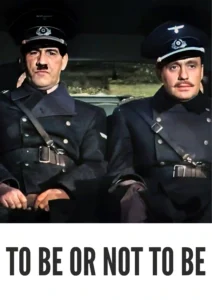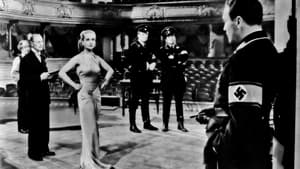Video Sources 0 Views
- Watch trailer
- To Be or Not to Be 1942 Colorized


Synopsis
Table of Contents
ToggleLaughter in Wartime: To Be or Not to Be (1942) in Stunning Color

Step into the daring world of To Be or Not to Be, a war satire comedy from 1942, now beautifully colorized for a viewing experience like never before. This film, directed by Ernst Lubitsch, delivers a hilarious blend of comedy, romance, and suspense set against the backdrop of World War II. Perfect for classic film enthusiasts and those seeking a bold and witty take on wartime, this HD download brings a timeless piece of cinematic history to your screen.
To Be or Not to Be Storyline: A Theatrical Act of Defiance
To Be or Not to Be follows a troupe of actors in Nazi-occupied Warsaw who use their theatrical skills to outwit the Germans. The story centers on Joseph Tura (Jack Benny) and his wife, Maria (Carole Lombard), renowned stars of the stage. When a young pilot, Lieutenant Stanislav Sobinski, falls for Maria and seeks her help, he inadvertently becomes entangled in a dangerous espionage mission.As the Nazis tighten their grip on Warsaw, the acting troupe, led by Tura, hatches a plan to impersonate high-ranking German officers to protect the Polish resistance. Disguises, mistaken identities, and daring performances ensue, creating a whirlwind of comedic chaos and suspense. The film culminates in a series of elaborate deceptions, showcasing the power of wit and satire in the face of oppression. Ultimately, To Be or Not to Be is a daring and entertaining film that celebrates the resilience of the human spirit. It is also known under the title Merry-Go-Round.
Movie Cast
The film features a stellar cast of actors who bring this audacious story to life:
- Carole Lombard as Maria Tura
- Jack Benny as Joseph Tura
- Robert Stack as Lt. Stanislav Sobinski
- Felix Bressart as Greenberg
- Lionel Atwill as Rawich
Movie Genre
To Be or Not to Be falls into the genre of war satire comedy, blending elements of humor, romance, and suspense. Its clever writing, sharp wit, and daring premise make it a unique and captivating film.
Historical Context: Wartime Cinema and Satirical Commentary
Released in 1942, To Be or Not to Be represents a bold and timely commentary on the events of World War II. The film was produced during a period when Hollywood was actively engaged in supporting the war effort, but it distinguished itself through its satirical approach to the conflict. While the film was initially met with some controversy due to its comedic portrayal of Nazis, it has since been recognized as a masterpiece of cinematic satire.
Colorization Details
This colorized version of To Be or Not to Be has been meticulously restored using modern digital techniques, enhancing the visual appeal while preserving the film’s original atmosphere. The colorization process involved carefully analyzing the grayscale tones of the original black and white footage and assigning appropriate colors to each scene. While the specific software used remains proprietary, the techniques employed included advanced algorithms for color palette selection and image enhancement. This painstaking process brings new life to the characters and settings, making the story even more engaging for modern audiences. While some may debate the merits of colorizing classic films, it introduces these films to a broader audience, ensuring their legacy for future generations.
Technical Details
- Director: Ernst Lubitsch
- Screenplay: Edwin Justus Mayer, Ernst Lubitsch
- Story: Melchior Lengyel
- Cinematography: Rudolph Maté
- Edited by: Dorothy Spencer
- Production Company: Ernst Lubitsch Productions
- Distributed by: United Artists
- Runtime: 99 minutes
Technical Specifications
- Download Format: MP4
- Resolution: HD (1080p)
- Compatibility: Compatible with most devices, including smartphones, tablets, computers, and smart TVs.
Reviews and Critical Reception
To Be or Not to Be (1942) is widely regarded as a masterpiece of cinematic satire, offering a daring and hilarious commentary on the events of World War II. Despite initial controversy, the film has since been recognized for its clever writing, sharp wit, and audacious premise. As a timeless and thought-provoking film, To Be or Not to Be remains a testament to the power of satire in the face of adversity.
FAQs
- Q: What is To Be or Not to Be about?
- A: To Be or Not to Be is a war satire comedy about a troupe of actors in Nazi-occupied Warsaw who use their theatrical skills to outwit the Germans.
- Q: Is To Be or Not to Be (1942) a controversial film?
- A: Initially, the film faced controversy for its comedic portrayal of Nazis, but it has since been recognized as a masterpiece of satire.
- Q: Is this version of To Be or Not to Be colorized?
- A: Yes, this version has been professionally colorized to enhance the viewing experience.
- Q: What makes To Be or Not to Be a classic film?
- A: To Be or Not to Be is a classic film due to its clever writing, sharp wit, and audacious premise, offering a timeless commentary on war and oppression.
- Q: What is the download format?
- A: The download format is MP4, which is compatible with most devices.
- Q: What resolution is the download?
- A: The resolution is HD (1080p), providing a high-quality viewing experience.
Download Now in HD!
Watch To Be or Not to Be Today!















